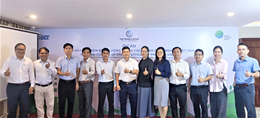Thứ sáu, 05/12/2025 | 18:54 GMT+7




















 [PODCAST: Góc chuyên gia] Phát triển nhân lực - Nền tảng cho hành động tiết kiệm năng lượng
[PODCAST: Góc chuyên gia] Phát triển nhân lực - Nền tảng cho hành động tiết kiệm năng lượng
 CHUYÊN GIA CHIA SẺ - SỐ 6: Sử dụng năng lượng tiết kiệm và hiệu quả trong công nghiệp
CHUYÊN GIA CHIA SẺ - SỐ 6: Sử dụng năng lượng tiết kiệm và hiệu quả trong công nghiệp
 CHUYÊN GIA CHIA SẺ - Số 8: Hiệu quả năng lượng và Đổi mới sáng tạo - Động lực cho doanh nghiệp phát triển bền vững
CHUYÊN GIA CHIA SẺ - Số 8: Hiệu quả năng lượng và Đổi mới sáng tạo - Động lực cho doanh nghiệp phát triển bền vững
 Sắp diễn ra Hội chợ Triển lãm Thiết bị Tiết kiệm năng lượng và Chuyển đổi xanh 2025
Sắp diễn ra Hội chợ Triển lãm Thiết bị Tiết kiệm năng lượng và Chuyển đổi xanh 2025
 CHUYÊN GIA CHIA SẺ - Số 7: Kết nối ngân hàng và doanh nghiệp để thực hiện các dự án tiết kiêm năng lượng
CHUYÊN GIA CHIA SẺ - Số 7: Kết nối ngân hàng và doanh nghiệp để thực hiện các dự án tiết kiêm năng lượng
 40 tác phẩm đạt giải báo chí tuyên truyền về sử dụng năng lượng tiết kiệm, hiệu quả năm 2025
40 tác phẩm đạt giải báo chí tuyên truyền về sử dụng năng lượng tiết kiệm, hiệu quả năm 2025
 HABECO nâng cao hiệu quả năng lượng trong sản xuất bia
HABECO nâng cao hiệu quả năng lượng trong sản xuất bia